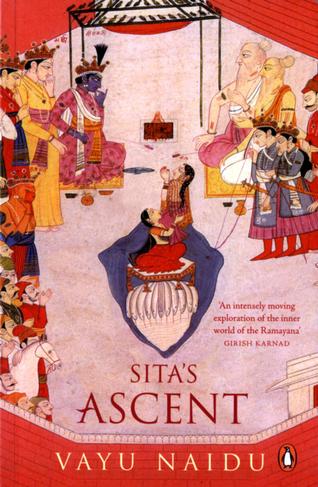Hi ….I’m back with an another story. ..which is based on Goddess sita’s life
The cover image of Vayu Naidu’s new novella,Sita’s Ascent, presents the most powerful picture of the Ramayana: of Sita returning to earth. As the very ground separates and the goddess holds her daughter in her arms, Rama, coloured a deep blue, seems rather contemplative. In Sita’s Ascent, he places his faith in Sita to understand why he did what he did. “She is central to everything. She will understand.” Then again, as you look at his face, you wonder, what was he thinking?
I was introduced to the story of Rama and Sita by my grandmother. “And so Rama rescued Sita from the clutches of Ravana and they returned to Ayodhya on the Pushpaka Vimanam. And then,” she would linger, “Rama was crowned king and they lived happily ever after.”
It was much later, at the end of my teens, that I discovered a story beyond the happily-ever-after, through several other retellings and books on mythology. Vayu Naidu’s story begins here. A pregnant Sita, still angry about the fire test, is on a chariot with Lakshmana, on the way to Valmiki’s hermitage. Sita looks at Valmiki’s home as her own. “Sita’s mother died a few years ago… the thought of contamination by strangers’ touch and her daughter’s life in danger made her wither into a skeleton. Her last words were ‘What will people say?’” It is then that Lakshmana informs her that she won’t be going back to Ayodhya. Rama had banished her to the forest. The pain had come back to haunt her.
After this point, it is difficult to explain Vayu’s story. In essence, it tries to see the epic from Sita’s point of view but does so through the eyes of other important characters in the epic. The result of this is not just a different perspective but also a balance. Vayu weaves in some interesting characters that are usually not at the fore; Urmila, Mandodari and Lava, who, with their share of insight, break down the epic not as a single story but as a concoction of different lives and circumstances.
There are even portions that suggest that some parts of the story are figments of Valmiki’s imagination. At one point, when Valmiki mentions Sabari’s patience, Lakshmana asks, “Is that why you wrote her in?”… “She was real. How else can anyone comprehend that degree of devotion?” This peep into the lives of the characters allows the reader to form their own opinions of what is real and what isn’t.
The author’s prowess in storytelling is evident as she shapes different characters in her tale. Valmiki brings lightness to the story as a funny, bellied sage whose mind works in different ways. “What kept seeping through the cracks of his mind, through the creative fissures, were the ideas for characters who would be written into his stories.” Soorpanaka is seen as an observer, who watches Valmiki tell stories and later reminisces about Sita’s grand swayamvarand how her indomitable cousin lost to Rama. “For the first time in all my lives I saw how crushed Ravana was by a woman, named Sita.”
The Trimurti — Brahma, Vishnu and Shiva — are so delightfully characterised that they often seem human. Most of the laugh-out-loud moments stem from the story behind the Rama avatar. When Ravana, granted a boon by Shiva, wreaks havoc in Devlok and Vishnu is summoned, he asks how one rakshasa can do so much damage. “Brahma was embarrassed. He coughed slightly. On earth, it caused rolling thunder in the sky… Brahma admitted to himself that it was time he made cuts on some executive privileges and extravagant personal expenses of devas. ‘Well… er, hmmm…’ was all he could say.” Shiva’s conversations with Nandi make the pair sound like two old friends who grew up together.
Though told in pieces, Sita’s story flows like a river, through the entire book. Vayu gives Rama the benefit of doubt, as a man torn between love for his wife and his country. Hanuman also witnesses this through an incident soon after the couple returns to Ayodhya. Lakshmana, on the other hand, cannot believe his part in the whole betrayal and tries to kill himself.
Yet, there are some parts of the story that leave you unnerved. Sita asks Lakshmana (when Rama is off catching the golden deer) if he stayed back to show her his true intentions. In another incident, Sita admits to only seeing Ravana’s toe but is almost excited when she sees a painting of him. The book does show Sita as a victim of circumstances, someone who accepts her fate.
But, in some parts, we see her as a woman with progressive thoughts, talking about how women always adapt to the husband’s home and make it their own. Then why does a woman like her, who is central to the epic, quell her anger so often? But I guess these are questions that won’t be easily answered. At the end of the day, Sita will always be the woman I grew up listening to.
In the end, Lava, narrating the story of his birth, provides his father with some perspective. The story ends as Rama realises his foll



6 Comments
Zara dear! Awesome write up 🙂
Thanks di
I want to share one thing. in some of the ramayana they will say that ravana didn’t touch Sita while abducting her he took the whole Sandy place under her feet. Bcoz he got one curse from one tapasvi woman as he tried to misbehave with her, if he touch any of the woman(Pati vratha) except mandodari he will be burnt at the same place. (I think it’s true my grand ma said this to me so I thought of sharing it, sorry if it is wrong)
U r right priya ……. .
Awesome Zara…..
Thanks di